
- Countries of the World
- Cities and provinces
- Complete Cooking Recipe Index
- Prophets' Stories
- All Countries of the World
- List of surahs in the Holy Qur'an
- Population of world countries by country
- Zip code in Jordan
- Traffic signs in Jordan
- List of world capitals
- International Calling Codes
- Al-Quran Recitations mp3
- List of currencies of the world
- Car Brand Logos and Names
- Jordanian Cuisine Guide
- Country codes names
- 6 Evergreen Content Topics
- World time zones by country
- Country flags of the world with images and names
- List of countries and dependencies by area
- List of countries and dependencies by population
Aqaba: Jordan's Sea Gateway and Oasis of Investment and Tourism

Historical Roots: Aqaba has been inhabited since 4,000 BC and has been a major trade hub for millennia.
|
Sea Port
The Only in Jordan
|
Economic Zone
Tax Free
|
Historical Age
6000 Years
|
Tourism Role
Sea Gateway to Petra
|
Aqaba: Where the Sea Meets the Desert and the Heart of National Economy
Also known as: Ayla, Aqabat Aylah, Aelana
Aqaba Governorate is one of Jordan's vital governorates, situated in the far south of the Hashemite Kingdom of Jordan.
- Center and Capital: Aqaba City is the capital and main urban center of the governorate.
- Sole Port: It serves as Jordan's only sea port, located on the Gulf of Aqaba, the eastern arm of the Red Sea.
- Climate: The climate is characterized by very hot summers and mild winters, positioning it as a warm, year-round resort destination.
- Economic Significance: Aqaba represents a vital hub for the Jordanian economy, hosting headquarters and factories for major corporations.
- Tourism: It is a crucial tourism center and a main starting point for both domestic and international travel routes.
- Marine World: Known as a warm Red Sea resort, it boasts a spectacular underwater environment featuring some of the world's most beautiful coral reefs.
- Special Economic Zone (ASEZA): In 2001, it was converted into a development zone that is exempt from customs duties and has reduced taxes. The zone encompasses the coastal strip (27 km), the ports, and the airport.
- Income Source: The population of the governorate largely depends on tourism as their primary source of income.
- Trade: The Port of Aqaba is the gateway through which nearly all of Jordan's foreign trade passes.
The Geographical and Strategic Location of Aqaba City
Aqaba is Jordan’s 6,000-year-old port city on the Red Sea, the gateway to the world-famous stone-city of Petra and a key stopover for ocean liners and cruise ships transiting the Suez Canal since the early 20th century.
1. General and Maritime Location
- Jordan's Deep South: Aqaba is situated in the far south of the Hashemite Kingdom of Jordan and serves as the capital of the Aqaba Governorate.
- Gulf and Red Sea: It lies at the head of the Gulf of Aqaba, a vital arm of the Red Sea.
2. Regional Borders and Meeting Points
Aqaba's position grants it paramount strategic importance, as it directly overlooks the borders of three countries and one territory:
- Western Border (Wadi Araba): Aqaba is linked to Occupied Palestine via the land border of Wadi Araba.
- Southern Border: It is adjacent to the Kingdom of Saudi Arabia (via the Durra border crossing).
- Maritime Connection: It is connected to the Arab Republic of Egypt via a sea route to the Port of Nuweiba in Sinai.
- Crossroads of Continents: Geographically, it is close to the meeting point of the continents of Asia and Africa.
3. Distance from the Capital
Aqaba city is located approximately 330 kilometers (or about a four-hour drive) south of the Jordanian capital, Amman.4. Astronomical Location and Elevation
- Astronomical Coordinates: 29∘31′56″N latitude and 35∘00′22″E longitude.
- Elevation: It ranges from approximately 6 to 13 meters above sea level.
This distinguished strategic location is what drove the Jordanian government to transform it into the Aqaba Special Economic Zone (ASEZA) to promote trade, tourism, and investment.
Aqaba Governorate consists of Two brigades:
Qasabat Aqaba Brigade, Al-Quwairah BrigadeCities, Towns, and Villages in Aqaba Governorate
Thanks to its large area and geographical diversity, Aqaba Governorate includes a wide range of population centers extending from the coast to the heart of the desert and Wadi Araba:
- 1. The Governorate Center and Coastal Areas
Aqaba (Al-'Aqaba): The capital and main city of the governorate. Al-Durra (Durra): An important border area to the south. Al-Muzaffar (Muzaffar), Taten, Al-Maqrah (Maqrah), Dabba Hanout, Al-Tawil (Tawil), Muneishir, Al-Ghal (Ghal), Taba (Referring to the settlement near the border area).
- 2. Southern Badia (Desert) Areas and Valleys
These communities include areas affiliated with the Al-Quwaira District (Liwa) and desert regions of tourist importance:
Al-Quwaira (Quwaira): The administrative center of the District. Rum: A village located in the heart of the tourist area of Wadi Rum (Valley of the Moon). Al-Disah (Disah): A region famous for its mountainous beauty and red sands. Al-Rashidiyyah (Rashidiya), Al-Humaimah Al-Jadidah (New Humaimah), Al-Humaimah (Humaimah), Al-Shakeriya (Shakeriya), Al-Salihiya (Salihiya), Al-Asaliya (Asaliya), Ain Al-Hawara, Al-Tuwaisa (Tuwaisa).
- 3. Villages of Wadi Araba and Northern Sub-Districts
These villages represent the western and northwestern part of the governorate within the Wadi Araba region:
Al-Risha (Risha), Al-Qurayqirah (Qurayqira), Rahma, Bir Mathkur, Qatar, Faynan (Fainan), Ghrandal (Gharandal).
Climate and Weather
Aqaba is characterized by its hot, arid desert climate, making it an ideal destination to escape the cold of winter, with long and intensely hot summers. Aqaba is known for enjoying abundant sunshine throughout the year and very low rainfall rates.
- Type: A hot, arid desert climate, distinguished by ample sunshine and very low rainfall.
- Summer: Long and intensely hot, with temperatures reaching 40∘C and higher.
- Winter: Warm and mild, with daytime temperatures ranging between 20∘C and 25∘C, making it a perfect getaway from the cold.
- Marine Activities: Its waters are warm all year round and contain unique coral reefs, which continuously support tourism and diving.
Tourism in Aqaba: The Intersection of Sea, Desert, and History
Aqaba is an active and excellent tourist destination, combining its status as a maritime and urban gateway with being a hub for unique desert and historical experiences, making it an area full of tourists all year round.
Marine Tourism and Coastal Recreation
Aqaba's main attraction is centered on its beaches on the Red Sea, characterized by beautiful weather and stunning waters:
- Diving and Coral Reefs: Aqaba is a world-class diving destination, offering more than thirty main dive sites and coral reefs extending over 25 kilometers. Diving is a major activity that contributes to prolonging a tourist's stay.
- Water Facilities: Luxury hotels and resorts, such as the Tala Bay Resort, are widespread, serving visitors who wish to enjoy the beaches and snorkeling.
- Al-Ghandour Beach: This is the closest public swimming beach in the Gulf of Aqaba, featuring glass-bottom boats and some cafes.
- National Importance: During holidays and long weekends, Jordanians from the north of the Kingdom (especially Amman and Irbid) flock here for short breaks, raising hotel occupancy rates to 100% during these periods.
- Marine Science Station: Located on the South Beach, it hosts a marine life exhibition where visitors can view the coral, fish, and endemic organisms of the Gulf of Aqaba.
Desert Tourism and Adventures
Aqaba benefits from its location as a gateway to the captivating desert regions in the south:
- Wadi Rum (Valley of the Moon): This stunning natural and geological site is located within Aqaba Governorate, characterized by its sandy and mountainous nature, where granite cliffs contrast with the desert sands.
- Jabal Umm ad Dami: Represents the highest elevation in all of Jordan and is located south of Aqaba, adding a tourist dimension for lovers of climbing and desert adventures.
Historical and Cultural Tourism
Aqaba offers unique historical and military landmarks:
- Naval Military Museum: A distinct tourist attraction established by the Economic Zone Authority, featuring more than thirty submerged military items, including a tank, a cannon, and two helicopters, aimed at encouraging and promoting diving.
- Cultural Landmarks: Cafes offer popular dishes such as Mansaf, Kunafeh, and Baklava.
- The Turkish Bath (Al-Hammam): A historical landmark built in 306 AD, it is a famous place for relaxation for both locals and visitors.
- International Recognition: In 2011, Aqaba was chosen as the Capital of Arab Tourism.
Information for Visitors and Tourists
|
Best Time
Nov-Apr
|
Duration
3-4 Days
|
From Amman
4 Hours
|
Language
Arabic/English
|
Jordanian Cuisine: Aqaba/Southern Specialties
The Jordanian cuisine in Aqaba forms a unique blend that combines the authentic Southern Bedouin heritage (for which the surrounding area and Wadi Rum are famous) with its identity as a coastal city offering fresh seafood and being an open economic zone. This variety is presented alongside the popular shared dishes of Jordan.
Southern Bedouin Dishes (Heritage)
As part of Southern Jordan, Aqaba shares the region's authentic Bedouin dishes, particularly those associated with the desert tourism in Wadi Rum:
- MansafMansaf
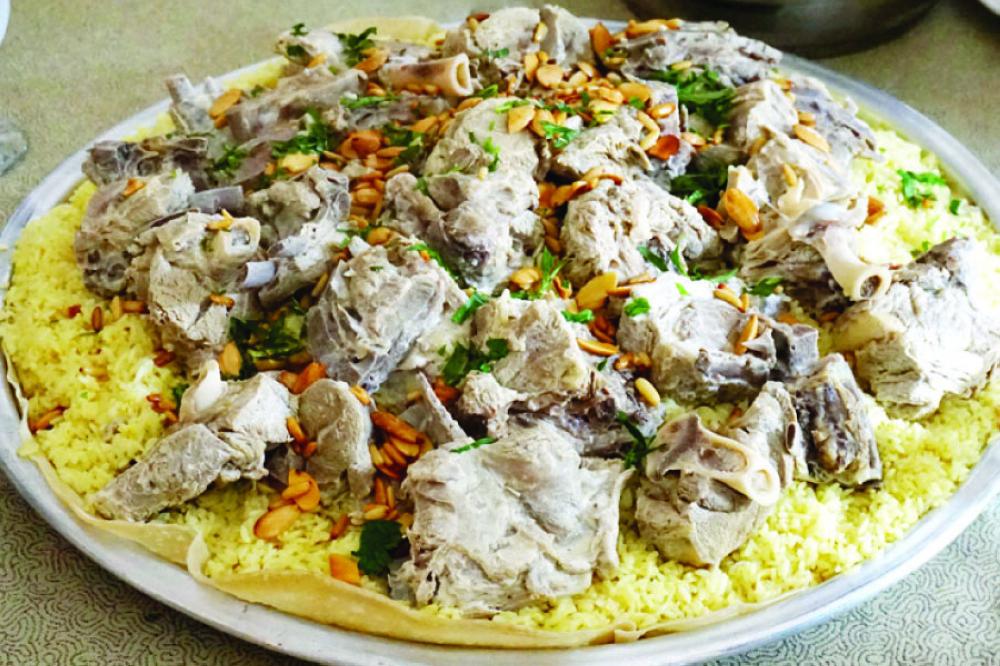 (المنسف): The national dish of Jordan, well-known across all regions. It consists of lamb cooked in a rich sauce made of jameed (dried fermented yogurt) and is served over a bed of rice and shrak bread. It is presented at major events such as wedding feasts, holidays, and also at condolence gatherings.
(المنسف): The national dish of Jordan, well-known across all regions. It consists of lamb cooked in a rich sauce made of jameed (dried fermented yogurt) and is served over a bed of rice and shrak bread. It is presented at major events such as wedding feasts, holidays, and also at condolence gatherings. - MaqlubaMaqluba
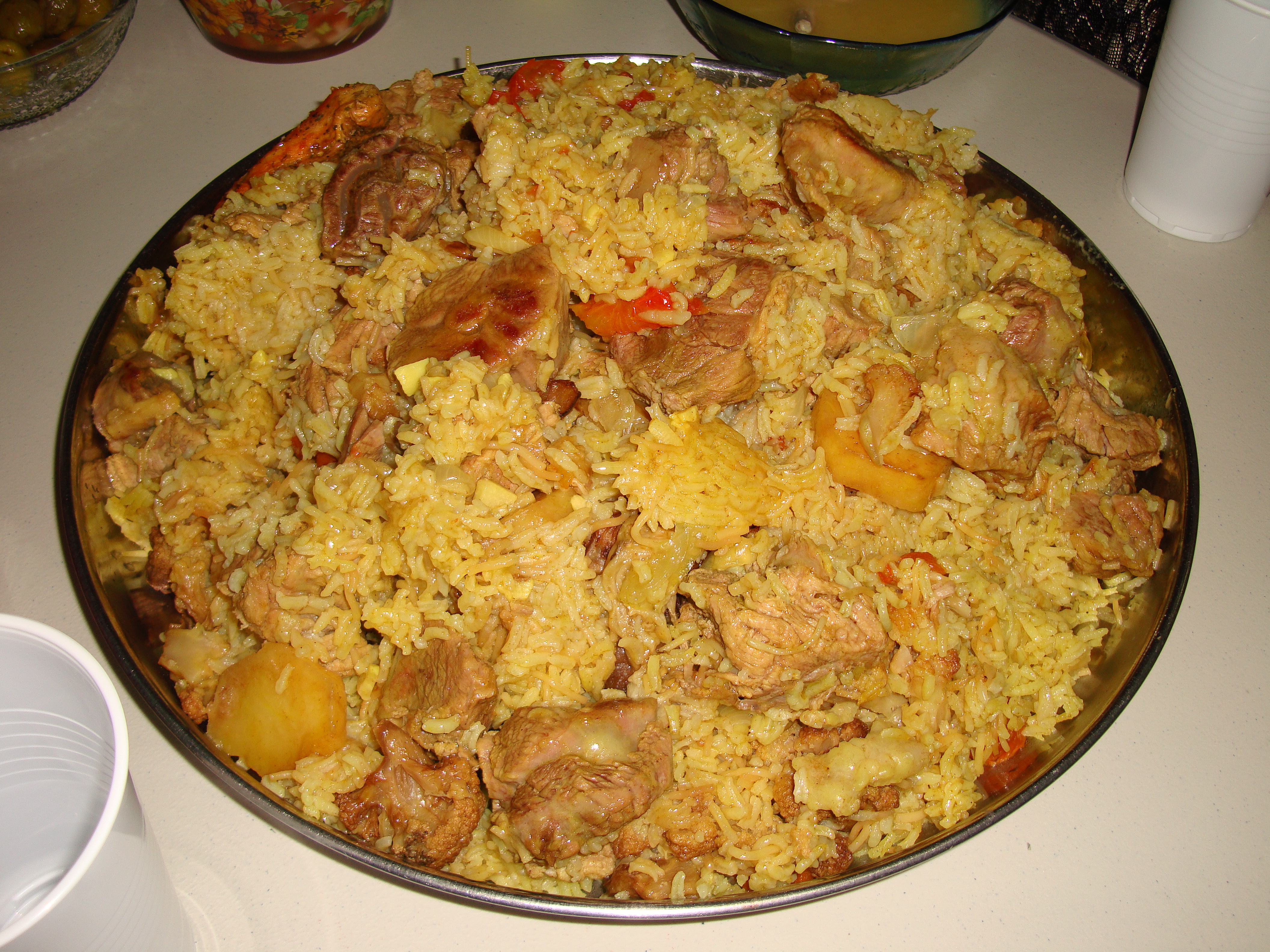 (المقلوبة): A casserole dish made by layering rice, vegetables, and meat. After cooking, the pot is flipped upside-down onto the serving platter, hence the name Maqluba, which literally translates to "Upside-down."
(المقلوبة): A casserole dish made by layering rice, vegetables, and meat. After cooking, the pot is flipped upside-down onto the serving platter, hence the name Maqluba, which literally translates to "Upside-down." - Al-Zarb (الزرب): The most distinctive and famous dish in Aqaba and Wadi Rum. Meat (lamb or chicken) is cooked along with vegetables inside a subterranean oven (tannour), which gives the meat a deeply smoky and extremely tender flavor.
Seafood Dishes (Coastal Cuisine)
The Aqaba region is distinguished by several specific local dishes, in addition to the popular meals found across Jordanian cuisine:
- Sayadieh (الصيادية): This is the most prominent seafood dish. It consists of cooked white fish (most often sea bass or grouper) served over rice seasoned with cumin and brown spices, typically garnished with nuts and parsley.
- Grilled and Fried Fish: Aqaba is renowned for serving exceptionally fresh fish that is either grilled or deep-fried immediately after being caught, especially in the restaurants near the port.
- Kishneh (الكِشْنة): A simple fish meal prepared by cooking fish, tomatoes, and onions together.
- Bukhari (البخاري): A celebratory dish often served at weddings. It consists of rice, meat, chickpeas, and ghee (clarified butter), seasoned with a distinctive blend of spices. (While not purely seafood, it represents the festive and communal cuisine of the region).
Shared Jordanian National and Popular Dishes
- MakmouraMakmoura
 (المكمورة): A foundational heritage dish primarily famous in the villages of Northern Jordan (Irbid and Ajloun). It is a thick, enormous pie made from layers of rolled dough, generously stuffed with copious amounts of minced onions, pieces of chicken or meat, and saturated with virgin olive oil and sumac. Makmoura is baked slowly over a low heat for an extended period (sometimes hours), making it a traditional winter feast and a symbol of generosity at major gatherings.
(المكمورة): A foundational heritage dish primarily famous in the villages of Northern Jordan (Irbid and Ajloun). It is a thick, enormous pie made from layers of rolled dough, generously stuffed with copious amounts of minced onions, pieces of chicken or meat, and saturated with virgin olive oil and sumac. Makmoura is baked slowly over a low heat for an extended period (sometimes hours), making it a traditional winter feast and a symbol of generosity at major gatherings. - Adhan al-ShayibAdhan al-Shayib
 (آذان الشايب - "Old Man's Ears"): Also known as Shish Barak, this is a famous dish across the Levant, especially in Jordan (specifically Northern Jordan), Syria, and even Central Asia (where it is known as Chuchvara in Uzbekistan, its likely origin). The dish consists of small dumplings made of dough filled with minced lamb and folded into the shape resembling a human ear. They are traditionally cooked in a warm yogurt sauce.
(آذان الشايب - "Old Man's Ears"): Also known as Shish Barak, this is a famous dish across the Levant, especially in Jordan (specifically Northern Jordan), Syria, and even Central Asia (where it is known as Chuchvara in Uzbekistan, its likely origin). The dish consists of small dumplings made of dough filled with minced lamb and folded into the shape resembling a human ear. They are traditionally cooked in a warm yogurt sauce. - Al-Ja’ajeelAl-Ja’ajeel
 (الجعاجيل - or Al-Ka'akeel/Al-Sha'asheel): These are specialized local folk dishes in the north that rely on dough balls or seasonal plant leaves cooked in a rich sauce of Jameed (dried yogurt) or fresh yogurt.
(الجعاجيل - or Al-Ka'akeel/Al-Sha'asheel): These are specialized local folk dishes in the north that rely on dough balls or seasonal plant leaves cooked in a rich sauce of Jameed (dried yogurt) or fresh yogurt. - Al-MutabaqAl-Mutabaq
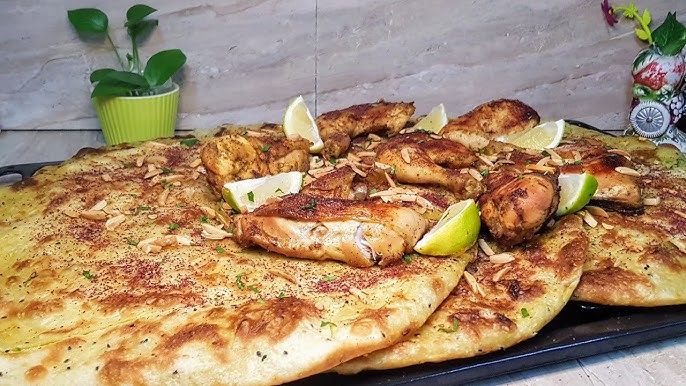 (المطبّق): A delicious dish considered a smaller-scale version of Makmoura, particularly famous in the villages of the Taybeh and Wastiyya districts.
(المطبّق): A delicious dish considered a smaller-scale version of Makmoura, particularly famous in the villages of the Taybeh and Wastiyya districts. - MaftulMaftul
 (المفتول): Large, pearl-like grains similar to couscous, which are cooked along with chickpeas and pieces of chicken in a rich, savory chicken broth.
(المفتول): Large, pearl-like grains similar to couscous, which are cooked along with chickpeas and pieces of chicken in a rich, savory chicken broth. - MusakhanMusakhan
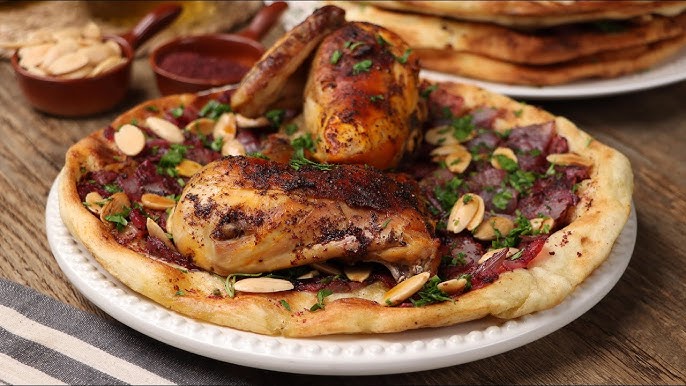 (المسخن): A famous Palestinian and Jordanian dish composed of baked roasted chicken seasoned with onions, sumac, spices, saffron, and fried pine nuts. It is served atop Taboon bread. It is also commonly known as Al-Muhannar.
(المسخن): A famous Palestinian and Jordanian dish composed of baked roasted chicken seasoned with onions, sumac, spices, saffron, and fried pine nuts. It is served atop Taboon bread. It is also commonly known as Al-Muhannar. - Al-Dafeen (Freekeh - الدفين): A staple meal centered around Freekeh (roasted green wheat grains). It is named Al-Dafeen (meaning "the buried") in some regions when it is prepared by burying it underground or cooking it over coals, which imparts a distinctive smoky and rich flavor (a cooking method shared with the Zarb barbecue technique in the south).
Tray Dishes and Quick Preparations
- Chicken Tray Bake (صينية الدجاج): A highly practical and widespread dish across all governorates. This involves seasoning chicken pieces and baking them in the oven with vegetables like potatoes and onions until they are well browned. It is traditionally served with rice.
- Meat Tray Bake (Kofta/Kofta Tray - صينية الكفتة): A meal prepared using seasoned minced meat (kofta), arranged in a tray with slices of vegetables such as potatoes and tomatoes. It is often covered with a tahini or tomato sauce before being baked to perfection in the oven.
- Kibbeh or Kebab (الكبة أو الكباب): These are widely popular dishes prepared in various forms (fried, grilled, or cooked in liquid) throughout different regions of Jordan.
- Kibbeh: Typically a mixture of burghul (cracked wheat), minced onions, and finely ground meat.
- Kebab: Generally refers to seasoned meat that is grilled or skewered.
Popular Appetizers and Daily Dishes in Aqaba
- Galayet BandoraGalayet bandora
 (قلاية البندورة - Fried Tomato Dish): A quintessential Jordanian and Levantine staple. This dish consists of diced tomatoes fried and simmered with onions, olive oil, salt, and chili pepper. While it can be served with rice, it is most commonly enjoyed in Jordan by dipping fresh bread into it. It is an indispensable meal for all segments of society across the governorates.
(قلاية البندورة - Fried Tomato Dish): A quintessential Jordanian and Levantine staple. This dish consists of diced tomatoes fried and simmered with onions, olive oil, salt, and chili pepper. While it can be served with rice, it is most commonly enjoyed in Jordan by dipping fresh bread into it. It is an indispensable meal for all segments of society across the governorates. - FalafelFalafel
 (الفلافل): Deep-fried balls or patties made from ground chickpeas (or fava beans) mixed with Middle Eastern spices. Falafel is a central part of any mezze platter and is especially common when dipping into Hummus. Jordanian Falafel patties tend to be smaller in size compared to other regional variations.
(الفلافل): Deep-fried balls or patties made from ground chickpeas (or fava beans) mixed with Middle Eastern spices. Falafel is a central part of any mezze platter and is especially common when dipping into Hummus. Jordanian Falafel patties tend to be smaller in size compared to other regional variations. - HuHummus and Ful MedamesHummus and Ful Medames
 (الحمص والفول - Chickpea Dip and Fava Beans): These two dips are traditionally served together for breakfast, particularly on Fridays. They are also common as appetizers (mezze) during lunch and dinner.
(الحمص والفول - Chickpea Dip and Fava Beans): These two dips are traditionally served together for breakfast, particularly on Fridays. They are also common as appetizers (mezze) during lunch and dinner.
- Hummus: A creamy dip made from mashed chickpeas, tahini (sesame paste), lemon juice, and garlic.
- Ful Medames: Stewed fava beans seasoned with lemon juice, garlic, and cumin.
Popular Sweets and Beverages
- Al-Huwwah (الحُوَّة): A traditional Aqaba pastry. It consists of layers of dough filled with nuts or dates, which is then fried and soaked in sugar syrup.
- Dates and Ghee (التمر والسمن): A simple sweet often served to guests, consisting of fresh dates dipped in Baladi Ghee (traditional clarified butter).
- BaklavaBaklava
 (بقلاوة): A rich, sweet dessert made with thin, crisp layers of phyllo pastryphyllo pastry
(بقلاوة): A rich, sweet dessert made with thin, crisp layers of phyllo pastryphyllo pastry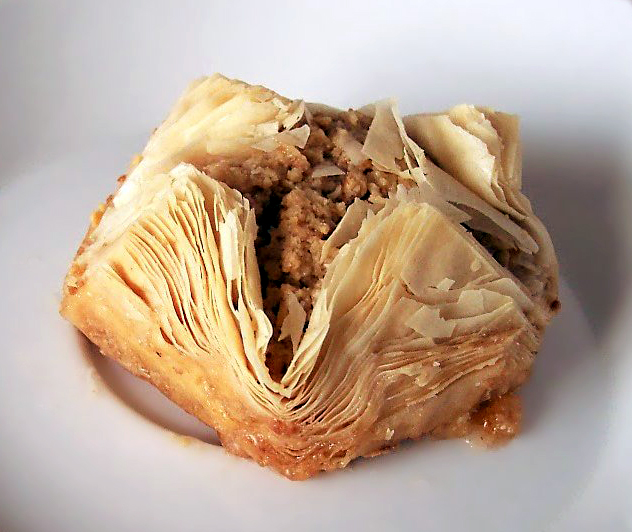 filled with chopped nuts (often walnuts or pistachios) and generously soaked in honey or simple sugar syrup.
filled with chopped nuts (often walnuts or pistachios) and generously soaked in honey or simple sugar syrup. - KnafehKnafeh
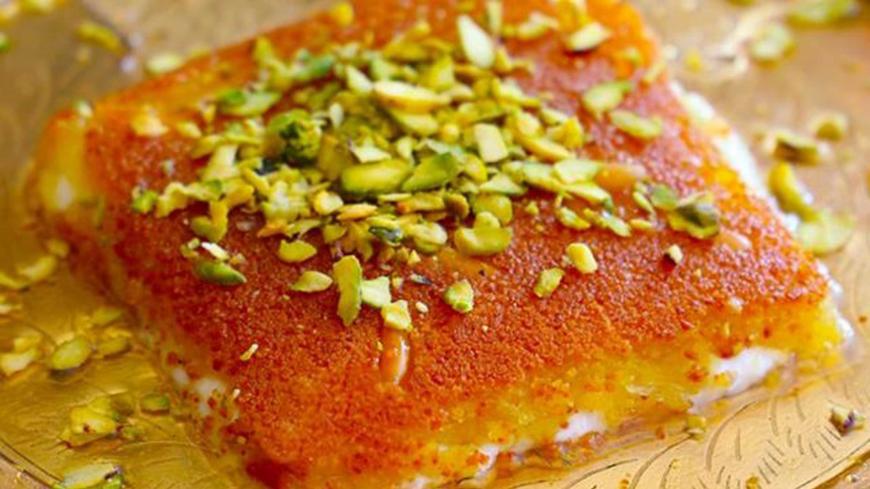 (كُنافة): A popular and distinctive Middle Eastern cheese pastry. It consists of shredded phyllo dough, or fine semolina strands, layered with soft cheese and drenched in a sugar-based syrup, often scented with rose water.
(كُنافة): A popular and distinctive Middle Eastern cheese pastry. It consists of shredded phyllo dough, or fine semolina strands, layered with soft cheese and drenched in a sugar-based syrup, often scented with rose water. - QatayefQatayef
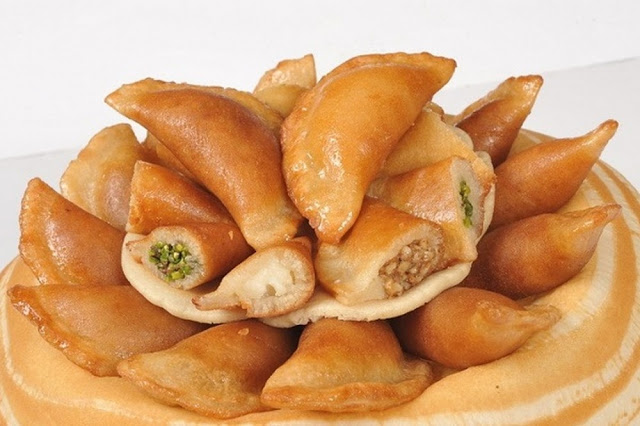 (قطايف): A sweet dessert dumpling unique to the region. It resembles a folded pancake, typically stuffed with fresh cream or ground pistachios, and is a famous treat consumed primarily during the holy month of Ramadan.
(قطايف): A sweet dessert dumpling unique to the region. It resembles a folded pancake, typically stuffed with fresh cream or ground pistachios, and is a famous treat consumed primarily during the holy month of Ramadan. - WarbatWarbat
 (وربات): A delicate, triangular pastry made of thin, flaky layers of phyllo pastry filled with a smooth, sweet custard (or fresh cream). Like Qatayef, it is frequently enjoyed during the month of Ramadan.
(وربات): A delicate, triangular pastry made of thin, flaky layers of phyllo pastry filled with a smooth, sweet custard (or fresh cream). Like Qatayef, it is frequently enjoyed during the month of Ramadan. - Al-Lazaqiyat (or Al-Sayalat - اللزاقيات): Classified as a dessert, this is a soft, simple dough poured onto a hot griddle (saj) and then drizzled with Arabic Ghee (sheep's butter) and honey or sugar.
- Cafes and Turkish Bath (Al-Hammam): Cafes and areas surrounding the traditional Turkish Bath offer Arabic coffee and hot Bedouin tea (prepared with sage or mint).
Area and Population of Aqaba Governorate
- Area (Governorate): Approximately 6,905 km² (2,666 mi²) (It is considered the fourth-largest governorate in Jordan by area).
- Population (Governorate): Approximately 188,160 inhabitants (According to the latest official estimates).
- Population Density: Relatively low, approximately 27.3 inhabitants per km².

Be the first to comment on this topic!
Leave a Comment